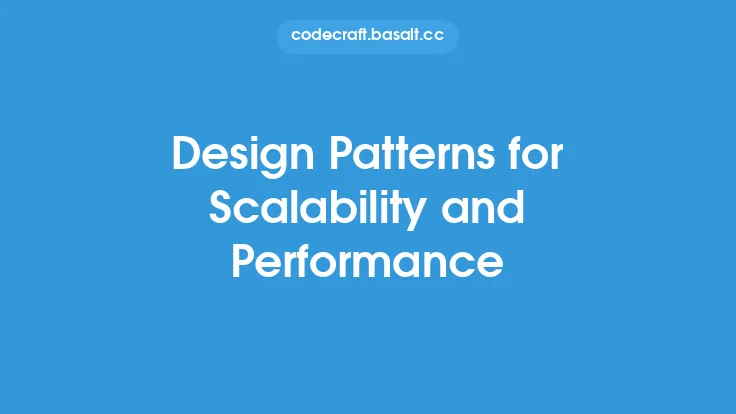When designing a database, it's essential to consider the specific use case and requirements of the application. Different use cases demand different database design patterns to ensure optimal performance, scalability, and data integrity. In this article, we'll explore common database design patterns for various use cases, highlighting their strengths, weaknesses, and applicability.
Introduction to Database Design Patterns
Database design patterns are reusable solutions to common database design problems. They provide a proven approach to designing databases that meet specific requirements, such as handling large amounts of data, ensuring data consistency, or supporting high-traffic applications. By applying established design patterns, developers can create databases that are efficient, scalable, and easy to maintain.
Entity-Attribute-Value (EAV) Pattern
The Entity-Attribute-Value (EAV) pattern is a design approach that stores data as a set of entities, attributes, and values. This pattern is useful when dealing with sparse data, where not all entities have all attributes. The EAV pattern consists of three tables: Entity, Attribute, and Value. The Entity table stores information about each entity, the Attribute table stores metadata about each attribute, and the Value table stores the actual values for each entity-attribute pair. The EAV pattern is commonly used in e-commerce applications, where products have varying attributes, such as color, size, and material.
Star and Snowflake Schemas
The Star and Snowflake schemas are design patterns used in data warehousing and business intelligence applications. The Star schema consists of a central fact table surrounded by dimension tables, which provide additional context to the fact data. The Snowflake schema is an extension of the Star schema, where each dimension table is further normalized into multiple related tables. These schemas are useful for analyzing large datasets and performing complex queries.
Tree-Like Structure Pattern
The Tree-Like Structure pattern is used to store hierarchical data, such as organizational charts, file systems, or product categories. This pattern uses a single table with a self-referential foreign key, which creates a tree-like structure. Each row in the table represents a node in the tree, and the foreign key references the parent node. The Tree-Like Structure pattern is useful for querying hierarchical data and performing recursive operations.
Graph Database Pattern
The Graph Database pattern is used to store complex relationships between data entities, such as social networks, recommendation systems, or knowledge graphs. Graph databases use nodes and edges to represent data entities and their relationships. This pattern is useful for querying complex relationships and performing graph algorithms, such as shortest path or community detection.
Event Sourcing Pattern
The Event Sourcing pattern is used to store the history of an application's state as a sequence of events. This pattern uses a single table to store all events, with each event representing a change to the application's state. The Event Sourcing pattern is useful for auditing, debugging, and reconstructing the application's state at any point in time.
CQRS (Command Query Responsibility Segregation) Pattern
The CQRS pattern is used to separate the responsibilities of handling commands (writes) and queries (reads) in an application. This pattern uses two separate databases or schemas, one for commands and one for queries. The command database stores the application's state, while the query database stores a denormalized view of the data for querying purposes. The CQRS pattern is useful for high-traffic applications, where the load on the database needs to be reduced.
Materialized View Pattern
The Materialized View pattern is used to improve query performance by storing the results of complex queries in a separate table. This pattern uses a materialized view table to store the pre-computed results, which can be updated periodically or in real-time. The Materialized View pattern is useful for applications with complex queries, such as data warehousing or business intelligence.
Database Design Patterns for Big Data
When dealing with big data, database design patterns need to be adapted to handle large volumes of data, high velocity, and variety. Some common database design patterns for big data include:
- Using a distributed database architecture, such as Hadoop or NoSQL databases, to store and process large amounts of data.
- Using a data lake architecture, which stores raw, unprocessed data in a centralized repository, to provide a single source of truth for all data.
- Using a lambda architecture, which combines batch and real-time processing, to handle high-velocity data streams.
Database Design Patterns for Real-Time Applications
When designing databases for real-time applications, such as gaming, finance, or IoT, database design patterns need to prioritize low latency and high throughput. Some common database design patterns for real-time applications include:
- Using an in-memory database, such as Redis or MemSQL, to store frequently accessed data.
- Using a streaming database, such as Apache Kafka or Amazon Kinesis, to handle high-velocity data streams.
- Using a graph database, such as Neo4j or Amazon Neptune, to store complex relationships between data entities.
Conclusion
Database design patterns are essential for creating efficient, scalable, and maintainable databases. By applying established design patterns, developers can ensure that their databases meet the specific requirements of their application, whether it's handling large amounts of data, ensuring data consistency, or supporting high-traffic applications. In this article, we've explored common database design patterns for various use cases, including EAV, Star and Snowflake schemas, Tree-Like Structure, Graph Database, Event Sourcing, CQRS, and Materialized View. We've also discussed database design patterns for big data and real-time applications, highlighting the importance of adapting design patterns to meet the specific needs of each use case. By understanding and applying these design patterns, developers can create databases that are optimized for performance, scalability, and data integrity.





